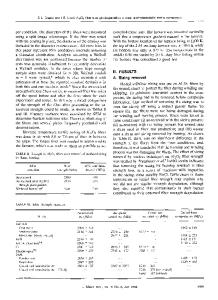Formation of Intermetallic Phases in Metal Matrix Composites
- PDF / 293,868 Bytes
- 5 Pages / 420.48 x 639 pts Page_size
- 61 Downloads / 420 Views
FORMATION OF INTERMETALLIC PHASES IN METAL MATRIX COMPOSITES
S.Dorfman, D.Fuks° and Joshua Pelleg* Department of Physics, Technion-Israel Institute of Technology, 32000 Haifa, Israel *Materials Engineering Department, Ben-Gurion University of the Negev, Beer Sheva, Israel
Abstract A theoretical study of the interaction between fibers and a matrix is performed, which is based on several approaches that axe connected with the calculation of mixing energy in multicomponent alloys or with the calculation of the diffusion coefficients in such systems. As an example, interatomic potentials for the alloys (AI,Si)-B, (Al,Mg)-B, (Al,Cr)-B, (AI,Mn)-B and (Al,Ga)-B are calculated. The values of the potential barrier Au for binary alloys are compared with those in ternary systems. It is shown that alloying of a binary alloy by Si reduces the height of potential in compaxison with the binary alloy. Other elements make this barrier higher.
The problem of reactions at the interface in metal matrix composites (MMC) during their fabrication and while in use is well known [1, 2]. Systems where interactions occur either during fabrication or during high temperature application are usually thermodynamically unstable. The nature of the interaction can be: a) solution of a fiber or a particle in the matrix which under extreme cases may result in complete degradation of the fiber ( particle), or b) formation of uncontrolled, undesirable and brittle intermetallic compounds. In Ref.[3, 4], for example, it is shown that the appearance of intermetallic phases at the matrix-fiber (matrix-particle) interface decreases significantly the mechanical properties of the material. The ideal case would be to have a system
where the matrix and the fiber are mutually nonreactive and insoluble, and only wetting occurs between them with modest diffusion bonding. Generally, however, in the most practical systems this is not true, and interaction either may continue the growth of intermetallic phases at the interface region or disintegration of the fiber occurs. Solid state diffusion is an important process to be considered in both cases. Kinetic studies of the diffusion process and the mechanism involved are essential for the development of the understanding of interface reactions in order to be able to control them. The experimental
investigations are complicated and expensive, but with the aid of theoretical calculations the experimental phase can be reduced for testing the correctness of the predictions. Theoretical investigations involving quantum-mechanical studies and calculations of thermodynamical functions are essential to predict
Mat. Res. Soc. Symp. Proc. Vol. 291. 01993 Materials Research Society
"444 the proper additive and its amount in order to eliminate growth at the interface region and thus control the perfomance of the composite. The basic idea to achieve reduced reaction rates at the interface is by decreasing the solubility of the fiber or the particles in the matrix. This can be done by alloying the matrix with an additional c
Data Loading...











